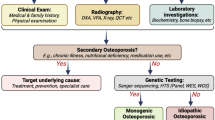Summary
Bone remodelling, a highly regulated succession of events, is the temporal sequence of osteoclastic bone resorption and osteoblastic bone formation. Bone loss with age and in osteoporotic patients is due to a desequilibrium between both processus. Bone histomorphometry was the method used to measure these events. Its shows clearly that, with age, the quantity of bone formed in one remodelling unit (so called mean wall thickness) decreases. In osteoporotic women, compared to control women of the same age the amount of bone formed is also decreased. Concordant data on this point have been obtained in different laboratories. By contrast, the cellular mechanism underlying this decreased amount of bone formed is largely controversial: a decreased osteoblast recruitment or life span or capacity to synthetise collagen have been suggested. Bone loss with age is associated with an increase in the amount of bone resorbed. This observation is the result of an indirect measurement founded on the distance between trabeculae. As the decreased bone formation, this processus is exaggerated in postmenopausal osteoporosis. The respective importance of decreased bone formation and increased bone resorption is however difficult to assess. Some osteoporotic patients have increased bone resorption surfaces compared to control women on their bone biopsy; however, it does not seem that these patients form a definite subgroup of osteoporotic patients as the extent of resorption surfaces changes with time in an untreated osteoporotic. In conclusion, the observed changes in bone remodelling in osteoporotic postmenopausal women are an exaggeration of those observed during ageing. These changes should be a basis for a coherent therapy of bone loss in osteoporotic patients.
Similar content being viewed by others
References
Parfitt, A.M., Mathews, C.H.E., Villanueva, A.R., Keleerekoper, M., Frame, B., Rao, D.S. Relationships between surface, volume and thickness of iliac trabecular bone in aging and in osteoporosis. Implications for the microanatomic and cellular mechanisms of bone loss. J Clin Invest 1983, 72, 1396–1409.
Merz, W.A., Schenk, R.K. Quantitative structural analysis of human cancellous bone. Acta Anat. 1969, 74, 140–149.
Nordin, B.E.C., Aaron, J., Speed, R., Grilly, R.G. Bone formation and resorption as the determinants of trabecular bone volume in postmenopausal osteoporosis. Lancet 1981, 8, 277–279.
Meunier, P.J., Courpron, P., Edouard, C., Alexandre, C., Bressot, C., Lips, P., Boyce, B.F. Bone histomorphometry in osteoporotic states. In: Barzel V.S. Osteoporosis II. Grune and Stratton, New York, 1979, 27–49.
Whyte, M., Bergfeld, M.A., Murphy, W.A., Avioli, L.V., Teitelbaum, S.L. Postmenopausal osteoporosis. A heterogeneous disorder as assessed by histomorphometric analysis of iliac crest bone from untreated patients. Am J Med 1982, 72, 193–202.
Garcia Carasco, M., de Vernejoul, M.C., Sterkers, Y., Morieux, C., Kuntz, D., Miravet, L. (1989) Decreased bone formation in osteoporotic patients compared with age-matched controls. Calcif Tissue Intern 1989, 44, In Press.
Vernejoul, M.C. de, Belenguer-Prieto, R., Kuntz, D., Bielakoff, J., Miravet, L., Ryckewaert, A. (1988). Bone histological heterogeneity in postmenopausal osteoporosis: a sequential histomorphometric study. Bone 1988, 8, 339–342.
Author information
Authors and Affiliations
Rights and permissions
About this article
Cite this article
de Vernejoul, M.C. Bone remodelling in osteoporosis. Clin Rheumatol 8 (Suppl 2), 13–15 (1989). https://doi.org/10.1007/BF02207227
Issue Date:
DOI: https://doi.org/10.1007/BF02207227




